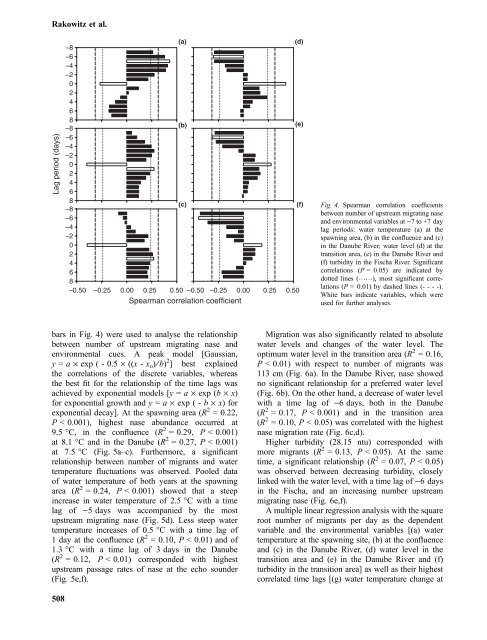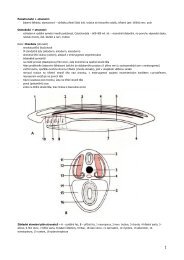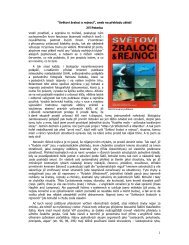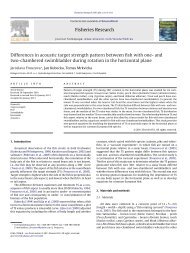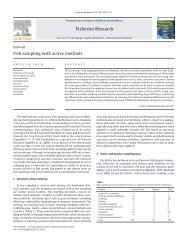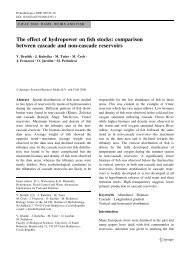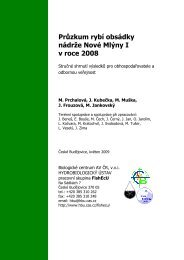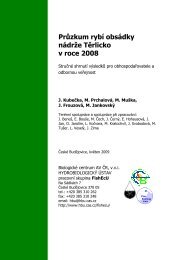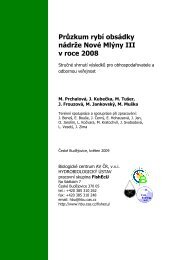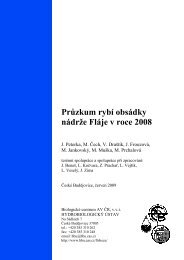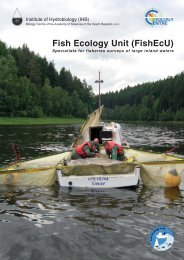Chondrostoma nasus - Biology Centre of the Academy of Sciences of
Chondrostoma nasus - Biology Centre of the Academy of Sciences of
Chondrostoma nasus - Biology Centre of the Academy of Sciences of
Create successful ePaper yourself
Turn your PDF publications into a flip-book with our unique Google optimized e-Paper software.
Rakowitz et al.<br />
Lag period (days)<br />
–8<br />
–6<br />
–4<br />
–2<br />
0<br />
2<br />
4<br />
6<br />
(a) (d)<br />
8<br />
–8<br />
–6<br />
–4<br />
–2<br />
0<br />
2<br />
4<br />
6<br />
(b)<br />
(e)<br />
8<br />
–8<br />
–6<br />
–4<br />
–2<br />
(c) (f) Fig. 4. Spearman correlation coefficients<br />
between number <strong>of</strong> upstream migrating nase<br />
and environmental variables at )7 to +7 day<br />
lag periods: water temperature (a) at <strong>the</strong><br />
spawning area, (b) in <strong>the</strong> confluence and (c)<br />
0<br />
in <strong>the</strong> Danube River; water level (d) at <strong>the</strong><br />
2<br />
transition area, (e) in <strong>the</strong> Danube River and<br />
4<br />
(f) turbidity in <strong>the</strong> Fischa River. Significant<br />
6<br />
8<br />
–0.50 –0.25 0.00 0.25 0.50 –0.50 –0.25 0.00 0.25 0.50<br />
Spearman correlation coefficient<br />
correlations (P =0.05) are indicated by<br />
dotted lines (……), most significant correlations<br />
(P =0.01) by dashed lines (- - - -).<br />
White bars indicate variables, which were<br />
used for fur<strong>the</strong>r analyses.<br />
bars in Fig. 4) were used to analyse <strong>the</strong> relationship<br />
between number <strong>of</strong> upstream migrating nase and<br />
environmental cues. A peak model [Gaussian,<br />
y = a · exp ( - 0.5 · ((x - x o) ⁄ b) 2 ] best explained<br />
<strong>the</strong> correlations <strong>of</strong> <strong>the</strong> discrete variables, whereas<br />
<strong>the</strong> best fit for <strong>the</strong> relationship <strong>of</strong> <strong>the</strong> time lags was<br />
achieved by exponential models [y = a · exp (b · x)<br />
for exponential growth and y = a · exp ( - b · x) for<br />
exponential decay]. At <strong>the</strong> spawning area (R 2 = 0.22,<br />
P < 0.001), highest nase abundance occurred at<br />
9.5 °C, in <strong>the</strong> confluence (R 2 = 0.29, P < 0.001)<br />
at 8.1 °C and in <strong>the</strong> Danube (R 2 = 0.27, P < 0.001)<br />
at 7.5 °C (Fig. 5a–c). Fur<strong>the</strong>rmore, a significant<br />
relationship between number <strong>of</strong> migrants and water<br />
temperature fluctuations was observed. Pooled data<br />
<strong>of</strong> water temperature <strong>of</strong> both years at <strong>the</strong> spawning<br />
area (R 2 = 0.24, P < 0.001) showed that a steep<br />
increase in water temperature <strong>of</strong> 2.5 °C with a time<br />
lag <strong>of</strong> )5 days was accompanied by <strong>the</strong> most<br />
upstream migrating nase (Fig. 5d). Less steep water<br />
temperature increases <strong>of</strong> 0.5 °C with a time lag <strong>of</strong><br />
1 day at <strong>the</strong> confluence (R 2 = 0.10, P < 0.01) and <strong>of</strong><br />
1.3 °C with a time lag <strong>of</strong> 3 days in <strong>the</strong> Danube<br />
(R 2 = 0.12, P < 0.01) corresponded with highest<br />
upstream passage rates <strong>of</strong> nase at <strong>the</strong> echo sounder<br />
(Fig. 5e,f).<br />
508<br />
Migration was also significantly related to absolute<br />
water levels and changes <strong>of</strong> <strong>the</strong> water level. The<br />
optimum water level in <strong>the</strong> transition area (R 2 = 0.16,<br />
P < 0.01) with respect to number <strong>of</strong> migrants was<br />
113 cm (Fig. 6a). In <strong>the</strong> Danube River, nase showed<br />
no significant relationship for a preferred water level<br />
(Fig. 6b). On <strong>the</strong> o<strong>the</strong>r hand, a decrease <strong>of</strong> water level<br />
with a time lag <strong>of</strong> )6 days, both in <strong>the</strong> Danube<br />
(R 2 = 0.17, P < 0.001) and in <strong>the</strong> transition area<br />
(R 2 = 0.10, P < 0.05) was correlated with <strong>the</strong> highest<br />
nase migration rate (Fig. 6c,d).<br />
Higher turbidity (28.15 ntu) corresponded with<br />
more migrants (R 2 = 0.13, P < 0.05). At <strong>the</strong> same<br />
time, a significant relationship (R 2 = 0.07, P < 0.05)<br />
was observed between decreasing turbidity, closely<br />
linked with <strong>the</strong> water level, with a time lag <strong>of</strong> )6 days<br />
in <strong>the</strong> Fischa, and an increasing number upstream<br />
migrating nase (Fig. 6e,f).<br />
A multiple linear regression analysis with <strong>the</strong> square<br />
root number <strong>of</strong> migrants per day as <strong>the</strong> dependent<br />
variable and <strong>the</strong> environmental variables [(a) water<br />
temperature at <strong>the</strong> spawning site, (b) at <strong>the</strong> confluence<br />
and (c) in <strong>the</strong> Danube River, (d) water level in <strong>the</strong><br />
transition area and (e) in <strong>the</strong> Danube River and (f)<br />
turbidity in <strong>the</strong> transition area] as well as <strong>the</strong>ir highest<br />
correlated time lags [(g) water temperature change at


